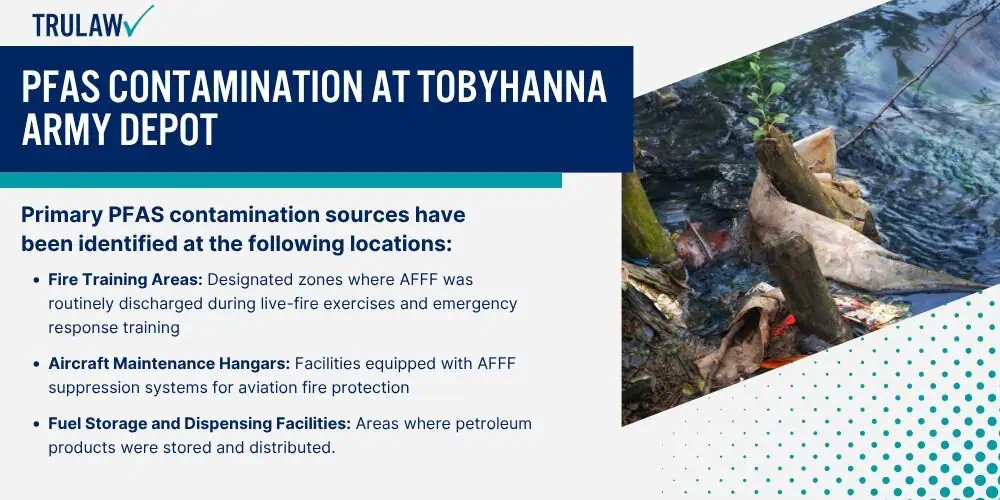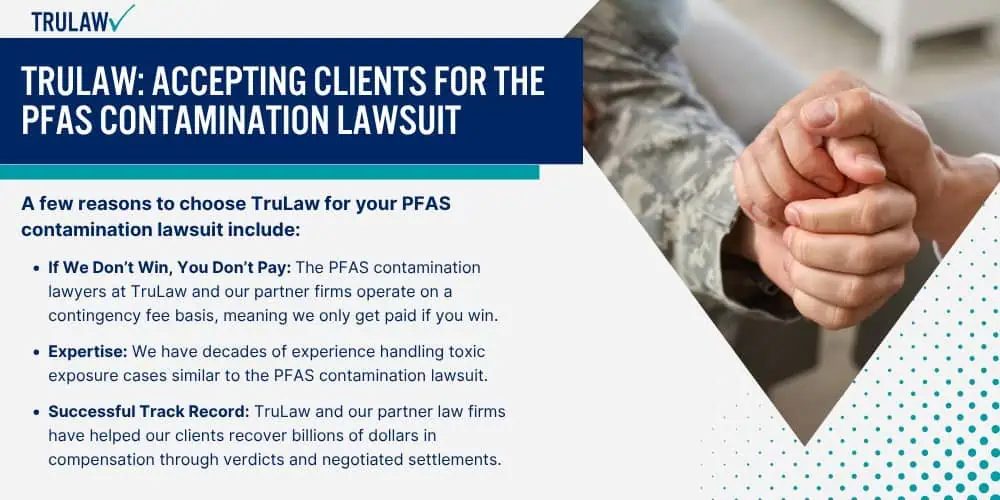Testing at Tobyhanna Army Depot, the region’s largest industrial employer with over 5,000 workers serving as the Army’s Center of Industrial and Technical Excellence for electronic systems, has revealed PFAS contamination levels that far exceed safety standards.
Environmental Working Group PFAS testing from 2020-2021 documented PFOS levels in groundwater at 1,300 parts per trillion (ppt) and PFOA at 630 ppt, representing 325 times and 157.5 times the EPA’s 2024 Maximum Contaminant Levels of 4 ppt respectively.

These toxic “forever chemicals” have contaminated the 20,000-acre installation in northeastern Pennsylvania’s Monroe County, where military operations have continued since 1953, exposing thousands of military personnel, civilian employees, and their families to serious health consequences through contaminated drinking water and occupational contact.
Sources of PFAS Exposure at the Facility
The primary source of known PFAS contamination at Tobyhanna Army Depot stems from decades of aqueous film forming foam (AFFF) use in fire training exercises and emergency response operations throughout the installation.
AFFF containing high concentrations of toxic PFAS chemicals was routinely sprayed at aircraft hangars, maintenance facilities, and designated fire training areas from the 1970s through recent years, allowing these persistent chemicals to seep into soil and groundwater systems.
Additional contamination sources include fuel storage areas, chemical storage facilities, and industrial operations supporting the depot’s electronics and avionics repair mission.
Primary PFAS contamination sources have been identified at the following locations:
- Fire Training Areas: Designated zones where AFFF was routinely discharged during live-fire exercises and emergency response training
- Aircraft Maintenance Hangars: Facilities equipped with AFFF suppression systems for aviation fire protection
- Fuel Storage and Dispensing Facilities: Areas where petroleum products were stored and distributed, requiring AFFF systems designed to resist heat for fire suppression
- Emergency Response Vehicle Storage Buildings: Structures housing fire trucks and emergency equipment with AFFF foam reserves
- Former Landfill Operations (1963-1979): Inactive waste disposal sites that received AFFF-contaminated materials during operational years
- Industrial Wastewater Treatment Areas: Facilities that processed AFFF-laden runoff and firefighting wastewater
- Chemical Storage and Disposal Sites: Locations where AFFF concentrates and empty containers were stored or discarded
Beyond these primary sources, PFAS contamination has spread through surface water runoff and groundwater migration, creating extensive contamination plumes that extend beyond the installation boundaries.
The depot’s location in the Pocono Mountains watershed has allowed PFAS to travel through natural drainage patterns, potentially affecting private wells and municipal water supplies in surrounding communities.
Environmental investigations have documented PFBS (perfluorobutane sulfonic acid) at 880 ppt in groundwater, adding another toxic PFAS compound to the contamination profile at levels 220 times above health advisory limits.
Timeline of Contamination Discovery and EPA Actions
Initial environmental concerns at Tobyhanna Army Depot emerged in the late 1980s when industrial contamination from electronics repair operations prompted regulatory scrutiny, leading to the site’s proposal for the National Priorities List (NPL) in July 1989.
The Environmental Protection Agency officially designated Tobyhanna as a Superfund site in August 1990, initiating comprehensive environmental assessments that focused initially on traditional contaminants like solvents and metals.
Two Records of Decision (RODs) were signed in 1996 addressing known contamination areas, and the Army achieved “construction complete” status in September 2000 for initial remediation efforts.
Milestones in Tobyhanna’s environmental history include:
- 1989 – NPL Proposal: The site was proposed for the National Priorities List after discovery of industrial contamination in soil and groundwater systems
- 1990 – Superfund Designation: The EPA officially designated Tobyhanna as a Superfund site, triggering federal cleanup requirements and oversight
- 1996 – Initial RODs Signed: Two Records of Decision were executed to address contamination in specific operational areas identified during site investigations
- 2000 – Initial Cleanup Completion: Construction complete status was achieved for the first phase of remediation activities outlined in the 1996 RODs
- 2016 – PFAS Health Advisory: The EPA issued a lifetime health advisory establishing 70 parts per trillion as the recommended limit for PFAS in drinking water
- 2020-2021 – PFAS Discovery: Comprehensive testing revealed PFAS contamination at levels far exceeding health advisory standards throughout the installation
- 2024 – Enforceable Standards: The EPA established legally enforceable Maximum Contaminant Levels of 4 parts per trillion for PFOA and PFOS in drinking water
The discovery of PFAS contamination represents a second wave of environmental challenges at Tobyhanna, as these toxic chemicals were not included in original Superfund investigations.
Current Army Environmental Command efforts include comprehensive site-wide PFAS assessments, groundwater monitoring well installation, and evaluation of potential exposure pathways.
Despite achieving construction complete status for earlier contamination, the PFAS crisis has reignited environmental concerns and prompted new investigations into the full extent of chemical migration and human health exposure risks throughout the depot’s operational history.
Who Is at Risk for PFAS Exposure
Military personnel who served at Tobyhanna Army Depot for one cumulative year or longer between 1970 and the present face the highest risk of PFAS exposure through contaminated drinking water systems and occupational contact during firefighting training or aircraft maintenance operations.
The depot’s role as a major electronics repair facility has employed thousands of civilian workers who may have unknowingly consumed PFAS-contaminated water during their employment, with exposure risks particularly elevated for those working near fire training areas, hangars, or fuel storage facilities.
Military families residing in on-base housing consumed the same contaminated water supply for drinking, cooking, and bathing, creating multi-generational exposure scenarios.
Populations at highest risk for PFAS exposure include (but are not limited to):
- Active Duty Military Personnel: Service members stationed at Tobyhanna face ongoing exposure through contaminated drinking water systems and occupational contact with AFFF
- Civilian Depot Employees and Contractors: Workers who maintain aircraft, vehicles, and fire suppression systems encounter PFAS through direct handling and contaminated work environments
- Military Families in Base Housing: Dependents living on-base receive contaminated water through residential plumbing systems connected to affected water supplies
- Firefighters and Emergency Response Personnel: First responders experience direct skin contact and inhalation exposure during AFFF deployment in training exercises and actual emergencies
- Aircraft and Vehicle Maintenance Workers: Technicians working in hangars and maintenance bays face exposure through AFFF system testing and accidental discharges
- Environmental Remediation Crews: Cleanup workers encounter concentrated PFAS while excavating contaminated soil and treating groundwater at identified hot spots
- Private Well Users Near Installation: Residents drawing water from wells downgradient of the depot may consume PFAS that migrated beyond installation boundaries
Beyond direct occupational and residential exposure, communities surrounding Tobyhanna Army Depot may have experienced PFAS contamination through groundwater migration into private wells and local water systems.
The depot’s location in the environmentally sensitive Pocono Mountains region means contamination can travel through fractured bedrock aquifers and surface water connections.
Pregnant women, children, and individuals with compromised immune systems face heightened vulnerability to PFAS health effects, making exposure assessment and medical monitoring particularly important for these populations who may have lived, worked, or received services at the installation during peak contamination periods.
If you or a loved one served, worked, or lived at Tobyhanna Army Depot and subsequently developed kidney cancer, testicular cancer, thyroid disease, or other serious health problems linked to PFAS exposure, you may be eligible to seek compensation.
Contact TruLaw using the chat on this page to receive an instant case evaluation and determine whether you qualify to join others in filing a Tobyhanna Army Depot PFAS lawsuit today.






